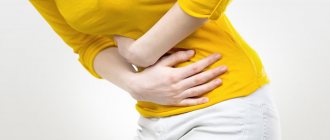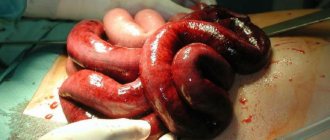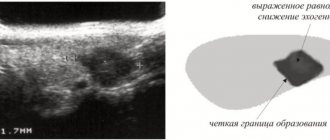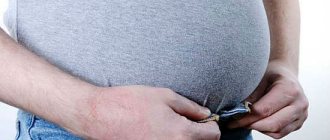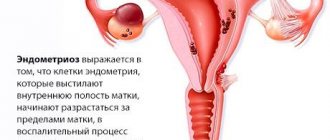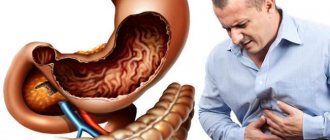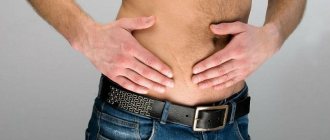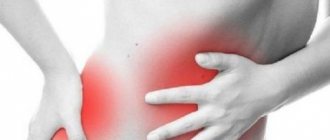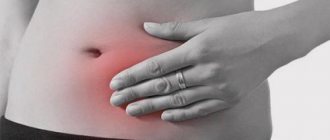Co-author, editor and medical expert - Klimovich Elina Valerievna.
Number of views: 34 677
Last updated date: 12/20/2021
Average reading time: 3 minutes
Pain in the upper abdomen is perhaps one of the most common complaints with which patients consult a gastroenterologist. This is a rather complex symptom that can be triggered by a number of factors. It can be temporary or permanent and indicate the occurrence of a particular digestive tract problem that needs to be addressed.
Causes of severe abdominal pain
The content of the article
There are many possible causes of sudden severe abdominal pain. The most common of these are intra-abdominal or pelvic diseases, for example:
- appendicitis;
- perforation of the gastrointestinal tract;
- colon diverticulosis;
- acute gastroenteritis;
- biliary colic;
- acute cholecystitis;
- acute cholangitis;
- acute pancreatitis;
- stones in the kidneys;
- acute pyelonephritis;
- acute cystitis;
- mesenteric artery embolism;
- thrombosis of visceral veins;
- abdominal aortic aneurysm.
In addition, in women, acute abdominal pain can cause:
In women, acute abdominal pain can cause
- acute adnexitis;
- ectopic pregnancy;
- torsion or cyst of the appendages.
Sometimes sudden severe abdominal pain is a symptom of metabolic or non-abdominal diseases, such as:
- myocardial infarction;
- inflammation of the heart muscle or pericardium;
- pneumonia and pleurisy;
- pulmonary embolism;
- increased levels of calcium in the blood;
- crisis of the thyroid gland or adrenal glands;
- food hypersensitivity;
- porphyria;
- ketoacidosis.
There are many more causes of acute abdominal pain, so diagnosing the cause of the pain can be quite difficult.
Abdominal injuries
The most dangerous are internal injuries to the abdominal organs.
The external consequences of abdominal injuries cannot be ignored; these are wounds, bruises, expressed by the formation of bruises. Abdominal injuries include strains of the abdominal wall muscles after intense physical activity.
They may be accompanied by the appearance of small hemorrhages and swelling. The most dangerous are internal injuries to the abdominal organs. Their causes are bruises, falls, concussions and blows with a blunt object.
Their danger is easy to underestimate, especially if there is no external damage. Damage to the internal organs of the abdominal cavity can be complicated by internal bleeding and peritonitis.
How does sudden severe abdominal pain manifest?
Acute abdominal pain is characterized by a sudden onset. This is usually a strong, well-defined pain that is felt most strongly in the affected area. It gets worse when you move, cough, breathe, or change body position. The pain may be accompanied by other symptoms, such as fever, vomiting, diarrhea, gas, and pain when urinating.
When examining a patient with acute abdominal pain, the physician may notice increased abdominal muscle tone as well as other abnormalities depending on the cause of the symptoms (eg, palpable abdominal resistance in the case of a tumor, symptoms consistent with renal colic, or cholecystitis).
Digestive diseases
Pain in the middle of the abdomen is caused by inflammation of the intestines.
This is the most common reason for the feeling that the middle of the abdomen hurts. Pain of such localization causes intestinal inflammation (enteritis). They develop due to the following factors:
- bacterial infection (dysentery, salmonellosis),
- viral infection (rotavirus),
- food poisoning,
- intoxication with alcohol, drugs, industrial hazards, helminthiasis.
Intestinal inflammation is accompanied by diarrhea, hyperthermia, vomiting, weakness, and lack of appetite. The following diseases and conditions can cause pain in the middle of the abdomen:
- Intestinal obstruction is a blockage of the intestine due to intestinal volvulus, tumor neoplasm, hernia, accumulation of parasites, adhesions. Accompanied by lack of stool, heaviness, flatulence, vomiting and nausea.
- Ulcerative lesions of the duodenum - the appearance of ulcers on the intestinal walls is accompanied by nausea and vomiting, and internal bleeding. The pain radiates to the back, to the pit of the stomach, to the lower back.
- Pancreatitis is inflammation of individual areas or the entire pancreas. Pain in pancreatitis radiates to the back and other areas of the peritoneum, and is very intense. Accompanied by vomiting, fever, and bloating.
Not only the health, but also the life of the patient may depend on a timely diagnosis of pancreatitis.
How does a doctor diagnose sudden severe abdominal pain?
How a Doctor Diagnoses Sudden Severe Abdominal Pain
A doctor diagnoses acute abdominal pain based on patient-reported symptoms and a physical examination of the abdomen.
Sudden severe abdominal pain is just a nonspecific symptom of many diseases. Therefore, it is necessary to diagnose the cause of the pain. This usually requires performing laboratory tests (including morphology, C-reactive protein, urinalysis, and others depending on the specific clinical situation) and imaging tests.
The main imaging study is abdominal ultrasound. Sometimes other tests, such as a CT scan of the abdomen, or an X-ray of the abdomen or chest, may also need to be done.
The nature of pain in the upper abdomen after eating
Acute intense pain
This feeling in the upper abdomen can be caused by food poisoning, overeating, constipation, indigestion, physical fatigue, muscle tension, injury, viral or bacterial infection, various psychogenic factors and many other reasons, sometimes not amenable to diagnosis.
Burning pain
Burning pain in the upper abdomen is often a consequence of eating hot, salty, sour or spicy foods, which irritate the gastric mucosa and lead to increased secretion of gastric juice.
Constant nagging pain
Most often it occurs due to overeating, eating dry food or due to quickly eating food on the go without first thoroughly chewing. Sometimes such a condition can develop as a reaction to certain foods.
to come back to the beginning
How to treat sudden severe abdominal pain?
Treatment for acute abdominal pain depends on the underlying cause.
- Symptomatically, each patient can be prescribed pain medication.
- In addition, antibiotic therapy or other causative measures may be required. For example, treatment of a heart attack manifested as epigastric pain.
- Some diseases that manifest as acute abdominal pain require surgical treatment. For example, abdominal aortic aneurysm, gastrointestinal perforation or acute appendicitis.
If your stomach hurts: 7 warning signs
Home — Social networks — If your stomach hurts: 7 warning signs
The ancient Slavs denoted “life” and “belly” in one word. And this had its own logic: everything that is most important for life is really stored in the stomach... Well, except, perhaps, for the brains: they would not have withstood the load that usually falls on the digestive system.
The Slavs (as well as other peoples living in our climate) love to eat. They always loved it and, by and large, they were right: they had to work hard and a lot, they spent the same amount of calories - naturally, the costs had to be replenished. To heat one's own body, additional calories and protective layers of fat were also required. Therefore, abundant nutrition was perhaps the main condition for survival.
But if in ancient times this healthy appetite was somehow restrained by the zone of risky farming, taxes, dues and raids of nomads, then in the era of the WTO, the load on the stomach increased significantly. A healthy appetite remains, but there are no restraining factors (well, except conscience). So there is nothing strange if every day in some place in the abdomen something gurgles, bursts and hurts from overload. It is not a fact that it is the digestive organ that hurts. Not the brain, that's for sure. But the rest cannot be one hundred percent sure. Someone there is giving signals, trying to remind you that by not sparing your belly, you are - literally - risking your life. Marina Yakusheva, a general practitioner at the Semeynaya medical clinic network, helped us decipher these messages.
Pain in the pit of the stomach, at the very top in the center (1)
SIGNAL: Stitching, cutting sharp pain, sometimes radiating to the chest area. She is accompanied by a feeling of fullness in the abdomen and flatulence.
Most likely it is... ...gastritis.
Unless, of course, you rule out the possibility that someone punched you in the gut. The most common cause of the disease is Helicobacter pylori microorganisms. They torment the gastric mucosa worse than hot peppers or alcohol (by the way, they are also gastritis provocateurs). Stress hormones stimulate excessive release of hydrochloric acid in the stomach - and here is another factor for the development of inflammation. That’s why there is a belief among people that “ulcers come from nerves.” With severe and prolonged pain, one can indeed suspect not just gastritis, but a stomach or duodenal ulcer.
CAUSES OF GASTRITIS
Gastritis is possible with increased acidity (hyperacid) - everything is clear with it: the acid irritates the walls of the stomach, and inflammation results. And it is also possible at low levels (hypoacid). The fact is that a low level of acidity, firstly, contributes to the prosperity of Helicobacter pylori bacteria, and secondly, does not ensure normal digestion of food, allowing it to rot.
But maybe this is... ...myocardial infarction.
This disease is often disguised as “something wrong with the stomach.”
If the pain also radiates to your left arm, call an ambulance immediately! …appendicitis.
It often begins with a vague pain in the pit of the stomach, and only then the pain signal moves to the right side and becomes very distinct. This is why it is usually not recommended to take painkillers for abdominal discomfort: this will complicate the diagnosis. Maybe an ambulance after all?
WHAT TO DO? Well, if there was no emergency hospitalization, still make an appointment with a gastroenterologist or therapist as soon as possible. And do not refuse gastroscopy: only this procedure will allow you to make a clear diagnosis and prescribe treatment.
Right hypochondrium hurts (2)
SIGNAL: Sharp, acute pain that occurs suddenly, accompanied by a feeling of heaviness, nausea, vomiting, and bloating. Gives to the right shoulder. Lasts for an hour.
Most likely, this is... ...biliary (hepatic) colic.
The reason for this is stones that lead to stagnation of bile. An attack can be triggered by severe stress, a festive feast (spicy, fatty, alcoholic), a long car ride on a bumpy road, and a bent over position (during cleaning floors, sex, or stretching exercises).
But maybe it’s... ...myocardial infarction,
especially in the presence of cardiovascular pathologies.
WHAT TO DO? Call a doctor, do not refuse hospitalization (doctors will most likely insist on it). You need to be examined by a surgeon, gastroenterologist, urologist. Be sure to tell your doctor if you are taking birth control pills - they may cause another attack. Eliminate fatty, salty foods and baked goods from your diet. Do not eat for 12 hours after the attack. Try to control your weight - if you have extra pounds, start getting rid of them.
SIGNAL: Noticeable discomfort or dull pain, loss of appetite.
Most likely, this is... ...Biliary dyskinesia.
That is, a violation of their motor skills. Because of this, problems arise with the flow of bile into the duodenum, as a result of which the entire digestion process is disrupted (primarily the digestion of fats).
But maybe it’s... ...acute hepatitis A or B,
exacerbation of chronic hepatitis C, or even cirrhosis of the liver. It is especially worth thinking about this if one of the symptoms is light-colored stools.
WHAT TO DO? Immediately contact a hepatologist and gastroenterologist. Even if the most terrible suspicions are not confirmed, you are still strictly forbidden to overeat (even on major holidays), the diet should be fractional: five to six times a day, in small portions, without fatty, smoked and spicy foods. And, of course, without alcohol.
Right side hurts at waist level (3)
SIGNAL: Severe cutting pain radiating to the lower abdomen and genital area. It has a wave-like flow, then fades, then intensifies.
Most likely, this is... ...renal colic.
The reason for this may be urolithiasis, kinking of the ureter, inflammation. Be careful when trying to lose weight. Excessive thinness is one of the provocateurs of kidney prolapse in nulliparous women. There is a lack of retroperitoneal fat, which helps the organs stay in place.
But maybe it’s also... ...inflammation of the ovaries
(adnexitis).
...osteochondrosis
(especially if the pain radiates to the lower back).
…appendicitis.
WHAT TO DO? If you have already encountered a similar situation, then take a painkiller or a drug that relieves spasms. Be sure to schedule a visit to the urologist the next day. Is the pain new? Gritting your teeth, without taking medications, wait for the ambulance to arrive. To make an accurate diagnosis, make an appointment with a gynecologist, neurologist and surgeon.
Left hypochondrium hurts (4)
SIGNAL: Aching pain that increases in intensity over time. Sometimes it seems to encircle the body. She is accompanied by nausea, dyspepsia, and bloating. It gets especially bad after eating fatty foods or strong alcohol.
Most likely it's... ...pancreatitis
– acute or chronic. The pancreas suffers. The outflow of juices containing digestive enzymes is disrupted. They begin to affect not the food, but the organ itself, leading to its destruction.
But maybe this is... ...bleeding from a stomach ulcer
and/or duodenum.
WHAT TO DO? Start sticking to a diet. Eat small meals five to six times a day. Alcohol is strictly prohibited, no butter or rich broths. If the symptoms increase quickly, getting worse every minute, call an ambulance, you need emergency help from a surgeon.
The very middle of the abdomen hurts (5)
SIGNAL: Flatulence, bloating, gurgling in the stomach, short-term aching pain.
Most likely it's... ...you overate.
The stomach, liver, intestines and pancreas simply could not cope with the loaded volume - and now gases move through the intestines, causing discomfort.
But maybe it’s also... ...dysbacteriosis.
Wait if you were sick and took antibiotics.
...lactase deficiency.
Pay attention to whether the described symptoms are related to the consumption of dairy products.
WHAT TO DO? Go to the nearest pharmacy and buy drugs that eliminate flatulence and enzymes that help digestion.
Pain right under the navel (6)
SIGNAL: Wandering pain “somewhere here.” Accompanied by bloating and stool disorders (alternating diarrhea and constipation).
Most likely it's... ...irritable bowel syndrome.
Such a fascinating topic that we are ready to devote a separate page to it!
But maybe it’s also... ...viral infections;
...gastroduodenitis.
WHAT TO DO? If the temperature rises and vomiting begins, call 03 urgently, take enterosorbents that help remove toxic substances from the body, drink more. And if there is no vomiting or fever, read the information on the next page.
Pain in the very bottom of the abdomen - in the middle, left or right (7)
SIGNAL: Drawing pain.
Most likely, this is... ...inflammation of the appendages.
But maybe it's... ...endometriosis.
…cystitis. …ectopic pregnancy. ...just constipation
due to irritable bowel syndrome.
WHAT TO DO? Feel free to start with a visit to the gynecologist. And - in any case - never, under any circumstances, self-medicate.
What are enzymes for?
Enzymes (they are also enzymes, they are also sourdough - if you go from Latin to Greek or Russian) - proteins that accelerate the occurrence of biochemical reactions in the body. The latter, with the participation of enzymes, provide us with energy for life and for cell synthesis. Without this, life is basically impossible. And digestion in particular.
Enzymes are produced both by the body itself - for example, the stomach, pancreas or cells of the small intestine - and by microorganisms that inhabit the intestines and other organs. In total, more than 20 enzymes are involved in the digestion process. Many of them begin to work only in the presence of partners - coenzymes (usually vitamins and minerals supplied with food).
Enzymes are very unstable substances: they just disintegrate. Therefore, a certain acidity and temperature are important to them (this is why, by the way, most people lose their appetite at high temperatures). When you eat a lot of fatty, spicy, smoked, salty foods, you change acidity. And if you consume healthy food, but in unhealthy quantities, then the standard dose of enzymes is not enough to digest it.
Advertising for this case suggests obtaining additional enzymes from tablets. But Dr. Yakusheva warns: “It is necessary to take enzymes regularly if you have chronic diseases of the pancreas. From time to time you can take them to help digestion during an acute intestinal infection or overeating... But if you constantly need pills, it means that your diet is significantly disrupted, and there is already some kind of malfunction in the body. That is, it’s time to see the doctor.”
Chronic colitis
If a patient experiences abdominal discomfort after eating food, the cause may be chronic inflammatory bowel disease. Any department becomes the source of damage:
- sigmoid colon;
- small or large intestine;
- duodenum.
Pain syndrome is characterized by varying degrees:
- spicy;
- pulling;
- cutting;
- cramping.
The last type of pain is less common than the others.
If the patient has a disease rather than a physiological condition, pain manifests itself as follows:
- develops from the center to the peripheral parts;
- persists on the sides of the abdomen;
- worsens after eating protein, fiber, coarse fibers.
Patients suffering from gastrointestinal pathologies are not recommended to consume legumes, cucumbers, dairy products, apples, and bran. Alcohol, fatty, spicy, fried foods, and chocolate can aggravate the symptoms.
During the course of the disease, additional signs may develop:
- reducing discomfort after taking oral or injectable antispasmodics, taking a hot shower or bath, applying a warm heating pad to the stomach;
- attenuation or complete elimination of pain after defecation;
- interruption in the normal formation of feces, it can be in the form of diarrhea or constipation;
- the urge to have a bowel movement without excreting feces;
- impurities of mucus, pus, blood in the stool.
To treat colitis, gastroenterologists prescribe the following medications:
- antispasmodics (Halidor, Drotaverine, No-shpa);
- the use of a high-quality, nutritious diet, but with the complete elimination of plant fiber.
Drugs that eliminate intestinal spasms can be taken in the form of tablets, injections, or rectal suppositories. When using the latter means, the effect occurs almost instantly.
If chronic colitis is not treated, complications will arise. A neurotic syndrome may form, accompanied by irritability, anxiety, insomnia and other mental disorders. Some patients even develop phobias.
Diseases of the reproductive organs
The lower abdomen in men may hurt due to acute prostatitis - inflammation of the prostate gland against the background of an infectious process, the causative agent of which is most often E. coli14. Classic symptoms are pain in the groin, lower abdomen and lower back, fever, chills. Urinary disorders are manifested by a feeling of incomplete emptying of the bladder, urination drop by drop, combined with frequent painful urges15.
Another reason is chronic prostatitis . This is the most common disease in men under 50 years of age: it is detected in 9% of the male population. Inflammation of the prostate is accompanied by aching pain in the lower abdomen, difficulty urinating, and sexual disorders14.
In 90% of cases, chronic prostatitis is accompanied by constant pain in the pelvis, sexual dysfunction, and urinary disorders. Such symptoms persist for at least 3 out of the last 6 months16.
The most common urological problem in older men is prostate adenoma (benign hyperplasia) . Enlarged prostate tissue can cause a narrowing of the lumen of the urethra. Therefore, in patients with prostate adenoma, the main complaints are similar to those usually observed with diseases of the urinary tract: weakening of the urine stream, intermittent or difficult urination, its frequency and urgency, as well as urinary retention and the inability to hold it when the urge occurs17.
Additional reasons
Other damaging factors associated with the development of the inflammatory process can cause pain during or immediately after eating food:
- inflammation of stomach tissue;
- inflammatory processes in the pancreas;
- duodenitis;
- ulcerative lesions of the gastrointestinal tract.
The following patients are at risk:
- sedentary;
- those who consume fast food and other types of junk food;
- experiencing stress, nervous tension, other types of psycho-emotional stress;
- irritable bowel syndrome, often in a state of spasm.
The exact pathogenesis of the condition has not been studied. But there are a number of fundamental reasons that lead to worsening pain after eating:
- disturbance of intestinal microflora;
- poor quality nutrition;
- dysfunction of endocrine organs, hormonal imbalance;
- damage to the urinary system.
If a patient has irritable bowel syndrome, the suppression of symptoms occurs after lunch, in the late afternoon. More often, the disease develops during breakfast, but gradually its intensity begins to decrease. The pathology usually affects people under the age of 40.
Soreness immediately after eating
One of the causes of pain immediately after eating was atherosclerosis of the vessels of the digestive tract. The following pathogenesis occurs:
- narrowing of the lumen of blood vessels with a decrease in blood flow to tissues;
- reduced supply of oxygen and nutrients, causing deformation and cell damage.
The more food the patient consumes, the stronger the discomfort becomes. Pain in the left iliac region takes on the following character:
- pressing;
- spilling.
Gradually, the pain syndrome can move from the left side to the right hypochondrium. To distinguish atherosclerosis of the digestive tract vessels from other pathologies, you need to pay attention to the following symptoms:
- reduction of discomfort after consuming Nitroglycerin;
- a short-term attack, the duration of which can reach a maximum of 15 minutes; in rare exceptions, the symptom lasts several hours;
- increased sweating, fear of approaching death, increased heart rate.
There are no pathogenetic treatments for the disease. Only symptomatic therapy is used, aimed at eliminating high cholesterol levels, dilating the lumen of blood vessels, and preventing thromboembolism. If a person’s condition is advanced, surgery may be required to provide the maximum effect.
Atherosclerosis of the gastrointestinal tract vessels is also called abdominal angina. This is a dangerous condition that can even lead to death. For example, when bleeding develops. Therefore, it is necessary to consult a doctor in a timely manner, conduct a diagnosis and begin treatment.
Treatment
Help before diagnosis
Considering that pain in the lower abdomen in men can have different origins, self-medication and independent use of painkillers are not recommended. To relieve symptoms, you should regularly empty your bladder and bowels and avoid prolonged sexual abstinence. Severe pain, combined with deterioration in well-being, is an indication for seeking emergency medical help.
Conservative therapy
In order to prevent polypharmacy, treatment of men with lower abdominal pain begins only after verification of the diagnosis. Treatment of most mild and moderate forms of diseases is carried out on an outpatient basis, and for severe and complicated diseases, hospitalization is necessary. The treatment regimen includes several groups of drugs, the main of which are:
- Antibiotics
. Medicines are prescribed for the treatment of acute and chronic prostatitis, STIs, and intestinal infections. The selection of the drug is carried out empirically, the drug regimen is adjusted after receiving the results of the antibiogram. - Alpha blockers
. Medicines relieve spasm of smooth muscles in men, facilitate the passage of urine, and therefore the pain syndrome decreases. For prostate adenoma, therapy is supplemented with 5-alpha reductase inhibitors. - Nonsteroidal anti-inflammatory drugs
. NSAIDs have a powerful analgesic effect, therefore they are used in both pathogenetic and symptomatic treatment of lower abdominal pain in men. - Immunomodulators
. Medicines that stimulate the immune system are necessary for chronic inflammatory and infectious processes. They prevent exacerbations and speed up the treatment process for men. - Cytostatics
. The drugs are effective in inflammatory bowel diseases to control symptoms and reduce the frequency of exacerbations. Cytostatics are included in the chemotherapy of genitourinary cancer in men.
For chronic prostatitis, prostate massage is widely used, which is necessary to eliminate congestion in the organ. For urological pain, physiotherapy methods are used: laser exposure, ultrasound and electromagnetic therapy, therapeutic microenemas. For IBS associated with psychoemotional disorders, psychotherapy techniques have a good effect.
Surgery
In the presence of prostate adenoma, several surgical options are used: transurethral resection, adenomectomy, laser vaporization of the prostate. In complicated forms of prostatitis, a puncture is performed with drainage of cysts and abscesses. Men with prostate cancer require radical surgery, which includes prostatectomy and lymph node dissection.
To treat urolithiasis, endoscopic operations (contact cystolithotripsy and ureterolithotripsy) and laparoscopic methods (nephrolithotomy, ureterolithotomy) are used. For inguinal hernias, hernioplasty is performed with the installation of mesh allografts. For appendicitis, gentle laparoscopic or classic laparotomic appendectomy is indicated.
